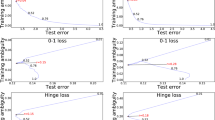Abstract
This paper describes a contingency-based approach to ensemble classification. Motivated by a business marketing problem, we explore the use of decision tree models, along with diversity measures and other elements of the task domain, to identify highly-performing ensemble classification models. Working from generated data sets, we found that 1) decision tree models can significantly improve the identification of highly-performing ensembles, and 2) the input parameters for a decision tree are dependent on the characteristics and demands of the decision problem, as well as the objectives of the decision maker.
Preview
Unable to display preview. Download preview PDF.
Similar content being viewed by others
References
Ali, K.M., Pazzani, M.J.: Error Reduction through Learning Multiple Descriptions. Machine Learning 24(3), 173–202 (1996)
Breiman, L.: Bagging predictors. Machine Learning 24(2), 123–140 (1996)
Chan, P.K., Stolfo, S.J.: On the Accuracy of Meta-learning for Scalable Data Mining. Journal of Intelligent Information Systems 8, 5–28 (1997)
Davenport, T.H.: Saving IT’s Soul: Human-Centered Information Management. Harvard Business Review, pp. 119-131 (March-April 1994)
Dietterich, T.G.: Machine Learning Research: Four Current Directions. AI Magazine 18(4), 97–136 (1997)
Dietterich, T.G.: An Experimental Comparison of Three Methods for Constructing Ensembles of Decision Trees: Bagging, Boosting, and Randomization. Machine Learning 40(2), 139–157 (2000)
Gal-Or, E., Gal-Or, M., May, J.H., Spangler, W.E.: Targeted Advertising Strategies on Television. University of Pittsburgh Working Paper (2005)
Gal-Or, M., May, J.H., Spangler, W.E.: Assessing The Predictive Accuracy of Diversity Measures with Domain-Dependent. Asymmetric Misclassification Costs. Information Fusion 6(1), 37–48 (2005)
Kittler, J., Hatef, M., Duin, R.P.W., Matas, J.: On Combining Classifiers. IEEE Transactions on Pattern Analysis and Machine Intelligence 20(3), 226–239 (1998)
Kuncheva, L.I., Whitaker, C.J.: Measures of Diversity in Classifier Ensembles and Their Relationship with the Ensemble Accuracy. Machine Learning 51(2), 181–207 (2003)
Kuncheva, L.I., Whitaker, C.J., Shipp, C.A., Duin, R.P.W.: Limits on the majority vote accuracy in classifier fusion. Pattern Analysis Applications 6, 22–31 (2003)
Lam, L., Suen, C.Y.: Application of Majority Voting to Pattern Recognition: An Analysis of Its Behavior and Performance. IEEE Transactions on Systems, Man and Cybernetics 27(5), 553–568 (1997)
Opitz, D., Maclin, R.: Popular Ensemble Methods: An Empirical Study. Journal of Artificial Intelligence Research 11, 169–198 (1999)
Partridge, D., Krzanowski, W.: Software Diversity: Practical Statistics for its Measurement and Exploitation. Information and Software Technology 39, 707–712 (1997)
Shipp, C.A., Kuncheva, L.I.: Relationships between combination methods and measures of diversity in combining classifiers. Information Fusion 3(2), 135–148 (2002)
Whitaker, C.J., Kuncheva, L.I.: Examining the relationship between majority vote accuracy and diversity in bagging and boosting. School of Informatics. University of Wales, Bangor (2003)
Author information
Authors and Affiliations
Editor information
Editors and Affiliations
Rights and permissions
Copyright information
© 2005 Springer-Verlag Berlin Heidelberg
About this paper
Cite this paper
Gal-Or, M., May, J.H., Spangler, W.E. (2005). Using Decision Tree Models and Diversity Measures in the Selection of Ensemble Classification Models. In: Oza, N.C., Polikar, R., Kittler, J., Roli, F. (eds) Multiple Classifier Systems. MCS 2005. Lecture Notes in Computer Science, vol 3541. Springer, Berlin, Heidelberg. https://doi.org/10.1007/11494683_19
Download citation
DOI: https://doi.org/10.1007/11494683_19
Publisher Name: Springer, Berlin, Heidelberg
Print ISBN: 978-3-540-26306-7
Online ISBN: 978-3-540-31578-0
eBook Packages: Computer ScienceComputer Science (R0)




